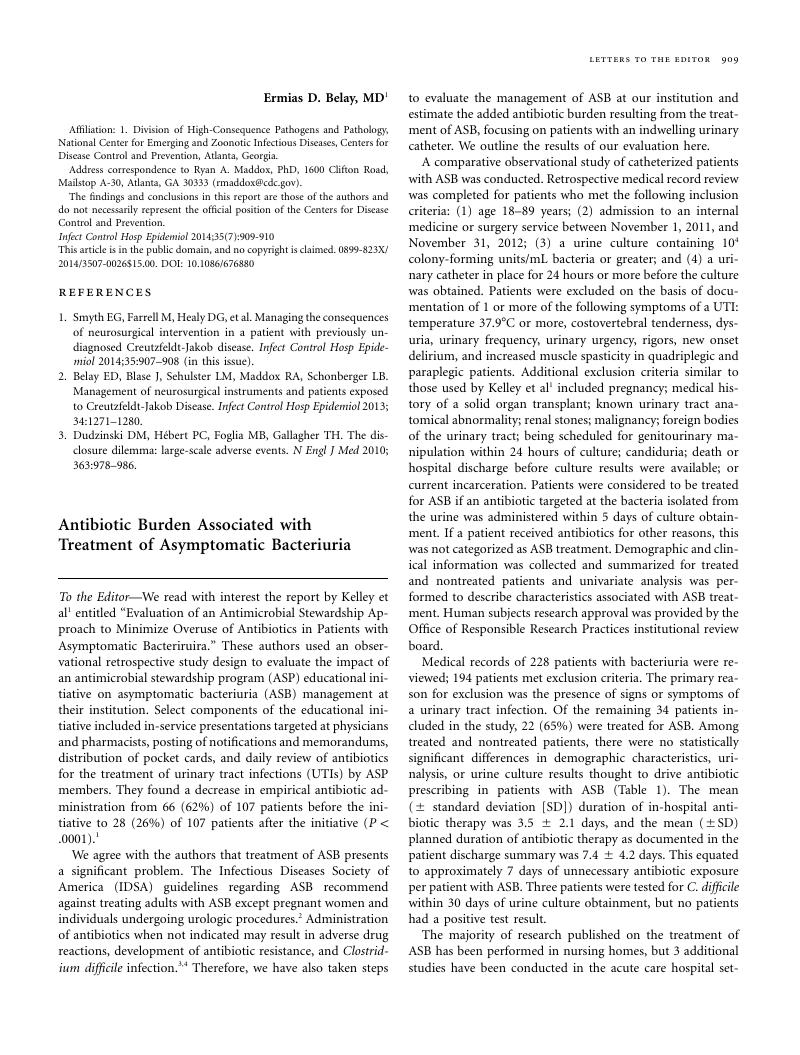No CrossRef data available.
Article contents
Antibiotic Burden Associated with Treatment of Asymptomatic Bacteriuria
Published online by Cambridge University Press: 10 May 2016
Abstract
An abstract is not available for this content so a preview has been provided. As you have access to this content, a full PDF is available via the ‘Save PDF’ action button.

- Type
- Letters to the Editor
- Information
- Copyright
- © 2014 by The Society for Healthcare Epidemiology of America. All rights reserved.
References
1.
Kelley, D, Aaronson, P, Poon, E, McCarter, YS, Bato, B, Jankowski, CA. Evaluation of an antimicrobial stewardship approach to minimize overuse of antibiotics in patients with asymptomatic bacteriuria. Infect Control Hosp Epidemiol
2014;35(2):193–195.CrossRefGoogle ScholarPubMed
2.
Nicolle, LE, Bradley, S, Colgan, R, Rice, JC, Schaeffer, A, Hooton, TM. Infectious Diseases Society of America guidelines for the diagnosis and treatment of asymptomatic bacteriuria in adults. Clin Infect Dis
2005;40:643–654.Google Scholar
3.
Nicolle, LE, Mayhew, WJ, Bryan, L. Prospective randomized comparison of therapy and no therapy for asymptomatic bacteriuria in institutionalized elderly women. Am J Med
1987;83:27–33.CrossRefGoogle ScholarPubMed
4.
Dellit, TH, Owens, RC, McGowan, JE, et al. Infectious Diseases Society of America and the Society for Healthcare Epidemiology of America guidelines for developing an institutional program to enhance antimicrobial stewardship. Clin Infect Dis
2007;44(2):159–177.CrossRefGoogle Scholar
5.
Cope, M, Cevallos, ME, Cadle, RM, Darouiche, RO, Musher, DM, Trautner, BW. Inappropriate treatment of catheter-associated asymptomatic bacteriuria in a tertiary care hospital. Clin Infec Dis
2009;48:1182–1188.Google Scholar
6.
Dalen, DM, Zvonar, RK, Jessamine, PG. An evaluation of the management of asymptomatic catheter-associated bacteriuria and candiduria at The Ottawa Hospital. Can J Infect Dis Med Microbiol
2005;16(3):166–170.CrossRefGoogle ScholarPubMed
7.
Silver, SA, Baillie, L, Simor, AE. Positive urine cultures: a major cause of inappropriate antimicrobial use in hospitals?
Can J Infect Dis Med Microbiol
2009;20(4):107–111.CrossRefGoogle Scholar
8.
Loeb, M, Brazil, K, Lohfeld, L, et al. Optimizing antibiotics in residents of nursing homes: protocol of a randomized trial. BMC Health Serv Res
2002;2(1):17.Google Scholar




